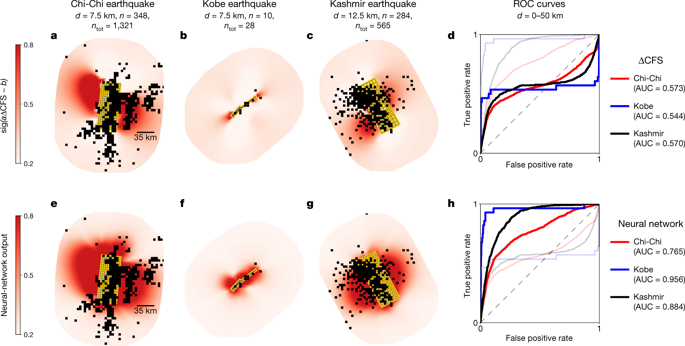Our official English website, www.x-mol.net, welcomes your
feedback! (Note: you will need to create a separate account there.)
Deep learning of aftershock patterns following large earthquakes
Nature ( IF 50.5 ) Pub Date : 2018-08-01 , DOI: 10.1038/s41586-018-0438-y Phoebe M R DeVries 1, 2 , Fernanda Viégas 3 , Martin Wattenberg 3 , Brendan J Meade 1
Nature ( IF 50.5 ) Pub Date : 2018-08-01 , DOI: 10.1038/s41586-018-0438-y Phoebe M R DeVries 1, 2 , Fernanda Viégas 3 , Martin Wattenberg 3 , Brendan J Meade 1
Affiliation

|
Aftershocks are a response to changes in stress generated by large earthquakes and represent the most common observations of the triggering of earthquakes. The maximum magnitude of aftershocks and their temporal decay are well described by empirical laws (such as Bath’s law1 and Omori’s law2), but explaining and forecasting the spatial distribution of aftershocks is more difficult. Coulomb failure stress change3 is perhaps the most widely used criterion to explain the spatial distributions of aftershocks4–8, but its applicability has been disputed9–11. Here we use a deep-learning approach to identify a static-stress-based criterion that forecasts aftershock locations without prior assumptions about fault orientation. We show that a neural network trained on more than 131,000 mainshock–aftershock pairs can predict the locations of aftershocks in an independent test dataset of more than 30,000 mainshock–aftershock pairs more accurately (area under curve of 0.849) than can classic Coulomb failure stress change (area under curve of 0.583). We find that the learned aftershock pattern is physically interpretable: the maximum change in shear stress, the von Mises yield criterion (a scaled version of the second invariant of the deviatoric stress-change tensor) and the sum of the absolute values of the independent components of the stress-change tensor each explain more than 98 per cent of the variance in the neural-network prediction. This machine-learning-driven insight provides improved forecasts of aftershock locations and identifies physical quantities that may control earthquake triggering during the most active part of the seismic cycle.Neural networks trained on data from about 130,000 aftershocks from around 100 large earthquakes improve predictions of the spatial distribution of aftershocks and suggest physical quantities that may control earthquake triggering.
中文翻译:

大地震后余震模式的深度学习
余震是对大地震产生的应力变化的反应,代表了对地震触发的最常见观察。经验法则(如巴斯定律1和大森定律2)很好地描述了余震的最大震级及其时间衰减,但解释和预测余震的空间分布则比较困难。库仑破坏应力变化 3 可能是解释余震空间分布的最广泛使用的标准 4-8,但其适用性一直存在争议 9-11。在这里,我们使用深度学习方法来确定基于静态应力的标准,该标准可以在没有事先假设断层方向的情况下预测余震位置。我们展示了一个神经网络训练了超过 131 个,000 个主震-余震对可以比经典的库仑破坏应力变化(曲线下面积 0.583)更准确地预测超过 30,000 个主震-余震对的独立测试数据集中的余震位置(曲线下面积为 0.849)。我们发现学习到的余震模式在物理上是可解释的:剪切应力的最大变化、von Mises 屈服准则(偏应力变化张量的第二个不变量的缩放版本)和独立分量的绝对值之和应力变化张量的每一个都解释了神经网络预测中超过 98% 的方差。
更新日期:2018-08-01
中文翻译:

大地震后余震模式的深度学习
余震是对大地震产生的应力变化的反应,代表了对地震触发的最常见观察。经验法则(如巴斯定律1和大森定律2)很好地描述了余震的最大震级及其时间衰减,但解释和预测余震的空间分布则比较困难。库仑破坏应力变化 3 可能是解释余震空间分布的最广泛使用的标准 4-8,但其适用性一直存在争议 9-11。在这里,我们使用深度学习方法来确定基于静态应力的标准,该标准可以在没有事先假设断层方向的情况下预测余震位置。我们展示了一个神经网络训练了超过 131 个,000 个主震-余震对可以比经典的库仑破坏应力变化(曲线下面积 0.583)更准确地预测超过 30,000 个主震-余震对的独立测试数据集中的余震位置(曲线下面积为 0.849)。我们发现学习到的余震模式在物理上是可解释的:剪切应力的最大变化、von Mises 屈服准则(偏应力变化张量的第二个不变量的缩放版本)和独立分量的绝对值之和应力变化张量的每一个都解释了神经网络预测中超过 98% 的方差。










































 京公网安备 11010802027423号
京公网安备 11010802027423号